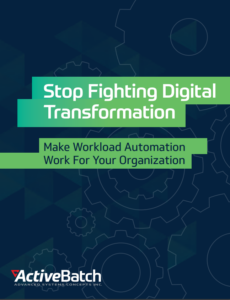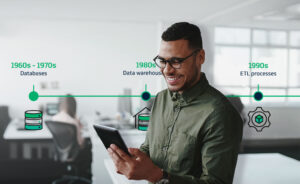2024: Gartner’s IT Automation Trends Revisited
Gartner’s IT Automation predictions include hyperautomation, hybrid infrastructure tools, and cost-overruns for digital transformation. Find out more.

Gartner’s 2023 IT automation predictions involved hyperautomation, hybrid infrastructure tools and cost-overruns for digital transformation. Now in 2024, let’s see if Gartner’s crystal ball was correct and what’s in the works this year.
Each year, Gartner, Inc. releases a series of papers explaining the trends that will impact business, IT and technology in the coming years. The 2023 predictions range from the growing rise of AI and the metaverse to sustainable technology and industry cloud platforms.
In general, most of Gartner’s 2023 predictions involved IT’s role becoming more prominent within the organization as digital business initiatives accelerate and mature. So to help IT professionals plan for the coming years, we reviewed Gartner’s research publications and pulled out the predictions most relevant to the IT automation market.
Overall, four major trends stick out:
- IT operations will be focused on optimizing resilience, trust and overall operations.
- The pace of automation is accelerating, with more organizations creating fully automated value chains.
- CIOs are focusing more on scaling up productivity, customer engagement and customer value, looking beyond just IT operations.
- Sustainable, easy-to-use technology solutions are becoming increasingly important.
Now, before diving into what exactly Gartner expected for IT automation in 2023 and what actually happened, let’s get some context out of the way.
IT Automation Predictions for 2023
- By year-end 2025, over half of the world’s population will be subject to at least one internet of behaviors (IoB) program (private, commercial or governmental).
- By 2025, 40% of physical experience-based businesses will improve financial results and outperform competitors by extending into paid virtual experiences.
- By 2024, organizations with IT teams that understand the needs of customers will outperform other organizations’ customer experience metrics by 20%.
- This year, it’s expected that 40% of all enterprise workloads will be deployed in cloud infrastructure and platform services, up from 20% in 2020.
- Through 2024, enhancements in analytics and automatic remediation capabilities will refocus 30% of IT operations efforts, from support to continuous engineering.
- By this year, it’s predicted that 40% of product and platform teams will use AIOps for automated change risk analysis in DevOps pipelines, reducing unplanned downtime by 20%.
- Gartner expects over 75% of large enterprises in mature economies will use container management by 2024 due to a growing adoption of cloud-native applications and infrastructure.
- By 2025, 50% of enterprises will have devised artificial intelligence (AI) orchestration platforms to operationalize AI, up from fewer than 10% in 2020.
Gartner split its 2023 predictions into three themes: customer centricity, geographic independence and operational resiliency. The overarching trend being that digital-first initiatives are accelerating — largely in response to COVID. During the pandemic, organizations re-envisioned traditional processes for the virtual realm. Businesses that rely on physical experiences, including amusement parks, sports venues, and museums, are moving toward virtual experiences that provide new business value and additional revenue streams.
Organizations across industries — from financial services to retail, healthcare to education — are leveraging new tools and technologies to provide new, virtual services. The race is now on to improve the customer experience by creating new digital processes that optimize those services. Data, artificial intelligence, cloud services, and the internet of things (IoT) will provide a foundation for emerging digital technologies organizations will need to maintain competitive advantage.
In 2023, Gartner introduced the term internet of behaviors (IoB). IoB programs rely on data collection and IoT to make intelligent decisions that impact customer behavior. A classic example of IoB would be an auto insurance company determining rates according to how a customer drives. The goal is to adjust the customer experience at the individual level, offering a level of service that benefits both the customer and the enterprise.
To make these new services possible, IT teams are moving more workloads to cloud environments, deploying new tools, and playing an increasingly critical role in day-to-day operations.
“Delivering technology alone will not be enough in 2023. Sustainable technology is a framework of solutions that increases the energy and efficiency of IT services; enables enterprise sustainability through technologies like traceability, analytics, emissions management software and AI; and helps customers achieve their own sustainability objectives.”
Gartner, Top 10 Strategic Technology Trends for 2023
Preparing For The “Digital Wall”
- By 2025, traditional computing technologies will hit a digital wall, forcing the shift to new computing paradigms such as neuromorphic computing.
- By 2024, 30% of digital businesses will mandate DNA storage trials, addressing the exponential growth of data poised to overwhelm existing storage technology.
- Through 2030, a wide range of new computing and storage technologies will continue to deliver improved digital capabilities and price points. Examples include glass storage, DNA storage, chemical computing, nanotube computing and memristors.
- By 2024, 75% of organizations will have deployed multiple data hubs to drive mission-critical data and analytics sharing and governance.
- By 2025, AI will be the top category driving infrastructure decisions, due to the maturation of the AI market, resulting in a tenfold growth in compute requirements.
The volume of data being created continues to rise exponentially. Data is a critical asset for organizations, providing a foundation for digital services, AI, natural language processing (NLP), deep neural networks, and much more. These technologies are also compute-intensive. Organizations are reaching a point where their data storage and computing are unable to keep up with the growth of data and technological advancements.
This is what Gartner has termed the “digital wall”. In order to keep pace with competitors and market demands, organizations will begin to test emerging storage and compute technologies, including DNA storage, glass storage, neuromorphic computing, and extreme parallelism.
The challenge for IT teams over the next two to three years is how to integrate new technologies and reliably manage big data across disparate environments.
“[In 2023, trends will] focus on enabling business model change, reinventing engagement with employees and customers, and accelerating strategies to tap new virtual markets.”
Gartner, Top 10 Strategic Technology Trends for 2023
Don’t let IT complexity hamper your digital goals
Get the latest trends and data on what’s driving transformation and how IT teams address these challenges.
Hyperautomation Is Here To Stay
- By 2025, customers will be the first humans to touch more than 20% of all products and produce.
- By 2024, organizations will lower operational costs by 30% by combining hyperautomation technologies with redesigned operational processes.
- By 2024, 80% of hyperautomation offerings will have limited industry-specific depth mandating additional investment for IP, curated data, architecture, integration and development.
- By 2024, more than 70% of the large global enterprises will have over 70 concurrent hyperautomation initiatives mandating governance or facing significant instability.
Hyperautomation, first included in Gartner’s 2020 predictions, has continued to evolve quickly. Driven by the pandemic and its impact on business operations, the need for accuracy and productivity has shifted more attention to automation.
Two key factors converge here:
- The economic uncertainty of 2021 and beyond has led organizations to reduce spending and to focus on operational efficiency.
- Despite overall spending cuts, spending for digital transformation has actually increased as organizations rapidly adapt their workflows, services, and business models.
The result is that organizations are leveraging AI and machine learning to automate as much as feasibly possible. By automating processes across the organization, organizations can reduce human error and make processes more efficient by removing human interventions and delays. Overall, automating processes end-to-end means fewer resources are needed to successfully complete the process, a boon for organizations that need to reduce operating costs while simultaneously providing faster services.
As we mentioned, hyperautomation isn’t new — many organizations had hyperautomation initiatives in 2021. As more organizations move toward digital-first initiatives, the volumes of processes and data IT teams must manage continue to surge, making it difficult for IT teams to stay afloat. By rapidly automating, IT teams are able to achieve much more without requiring more resources. The difference between 2022 and 2023 is that for 2023 and beyond, hyperautomation is accelerating.
By 2025, more than 20% of all products will be manufactured, packed, shipped, and delivered without being touched — the person who purchases the product will be the first person to touch it. The fully automated value chain is a result of hyperautomation. As organizations automate more and more tasks, those tasks are being organized and scheduled into end-to-end processes that are more efficient, more reliable, more scalable, and easier to adapt.
Technological progress is helping to drive hyperautomation as well: Gartner expects that by this year, organizations will be able to run a full 25% more tasks autonomously. While much of this will be achieved through the use of robotic process automation (RPA) in front-end offices, critical operations, infrastructure, and data processes will need to be automated with more robust orchestration and automation tools that provide programmatic integrations and deeper functionality.
Additionally, automation providers are looking to platform engineering to provide a curated set of tools, capabilities and processes that are easily incorporated into daily use by developers. This reduces the demands on developers while allowing these tools to be used by a great set of users, boosting overall productivity and results.
The Role Of The CIO Is Evolving
- By 2025, one in 10 technology leaders will find themselves the de facto leader of customer experience for their organization.
- By 2024, 25% of traditional large enterprise CIOs will be held accountable for digital business operational results, effectively becoming “COO by proxy.”
The future of the business runs through the IT department. Most organizations seem to recognize this. As business models shift toward digital-first processes and services, IT is playing an increasingly critical role in day-to-day operations. This is having an impact on how the organization regards IT.
Because IT services have become central to the success of the business, business leaders are asking IT teams — and especially IT leaders — to play a larger role in devising long-term business strategies. Part of this change means that CIOs are taking on new responsibilities. This includes conferring digital knowledge to other executives in the organization, taking leadership over digital business operations, and playing a direct role in designing and implementing customer experiences.
This change can be a two-way road, however: while the CIO is becoming more closely aligned with the business, the COO is becoming more closely aligned with IT. This makes IT, and the organization’s digital infrastructure, inseparable from day-to-day operations and five-year plans.
This will increase pressure on IT. No longer will it be enough to play a supporting role in the organization, IT teams will be responsible for business outcomes.
As IT leaders take on new roles within the organization, composable infrastructure and services will become necessary in order to quickly adapt to evolving business needs.
Gartner lists four principles for creating a composable business:
- Modularity
- Autonomy
- Orchestration
- Discovery
In order to pivot to meet new challenges, crises, and trends, IT teams will need the ability to rapidly integrate, orchestrate, and deploy new processes and services. This will require intelligent automation software and process orchestration tools.
“Composable business is a natural acceleration of the digital business that you live every day. It allows us to deliver… real-time adaptability and resilience in the face of uncertainty.”
Gartner Keynote: The Future of Business Is Composable
Other Notable Predictions
Gartner has released over two dozen papers related to current technology trends. Many of these other predictions are related to IT automation, but aren’t exactly central to Gartner’s main themes for 2022. This includes cloud computing.
Over the next few years, Gartner expects cloud to continue to evolve as more organizations move toward distributed, hyperscale, and hybrid cloud options and away from on premise software. This will increase complexity for IT environments, requiring IT to streamline the provisioning of cloud-based resources as well as configuration management.
- By 2025, more than 50% of organizations will use a distributed cloud option at the location of their choice, enabling transformational business models.
- By year-end 2023, 20% of installed edge computing platforms will be delivered and managed by hyperscale cloud providers, compared to less than 1% in 2020.
- Gartner expects over 75% of large enterprises in mature economies will use container management by 2024 due to a growing adoption of cloud-native applications and infrastructure.
- By 2024, 75% of organizations monitoring IaaS/PaaS environments will consume metrics via cloud providers’ APIs.
While IT might be getting busier, it’s also becoming more efficient through autonomous IT capabilities.
- Through 2024, enhancements in digital workplace infrastructure processes driven by analytics and automatic remediation capabilities will refocus 30% of IT operations management, from support to continuous engineering.
- By 2024, endpoint analytics and automation will help digital workplace service staff shift 30% of time spent on endpoint support and repair to continuous engineering.
- By this year, it’s predicted that 40% of product and platform teams will use AIOps for automated change risk analysis in DevOps pipelines, reducing unplanned downtime by 20%.
- 76% of survey respondents say that demand for new digital products and services increased in 2020. Even more respondents (83%) say that it will increase in 2021.
The pandemic presented a unique opportunity for businesses to embrace digital transformation. With it came a mandate unlike any other to empower users to work digitally and conduct business more efficiently from homes, offices and around the world. Now businesses can incorporate these digital advances into their operating models as they continue to add in new technologies — AI, machine learning, automation and more.
It’s been a tremendous period, and in many ways CIOs and IT teams have risen to the occasion and delivered beyond expectations. We now operate in a new normal this is founded on agility, transformation, and constant change.
Ready to see how we make workload automation easy?
Schedule a demo to see how easy it is to build and maintain your jobs in ActiveBatch.
Frequently Asked Questions
IT automation is a broad field that includes everything from job scheduling to infrastructure management. IT task scheduler software can be used to develop, monitor, and manage automated tasks that support intelligent process automation, data center automation, IT infrastructure, secure file transfers, software development, and much more. Explore our in-depth IT automation explainer.
Automation is being used to reduce time-consuming manual processes needed to manage surges in data and digital tools. In order to increase efficiency, organizations are implementing hyperautomation initiatives and using artificial intelligence and machine learning to streamline, monitor, and manage automated processes. Overall, intelligent process automation technologies are becoming central to process orchestration goals within IT and business departments. Learn more about automation and orchestration. Learn more about automation and orchestration.
Gartner’s top automation predictions for 2023 include growth in hyperautomation, IT systems becoming increasingly critical as organizations rely on business process automation to deliver digital experiences, and new data storage and compute technologies as a result of organizations reaching a digital wall. Read the full breakdown of Gartner’s 2022 IT automation predictions.








